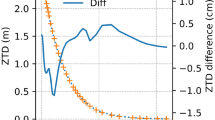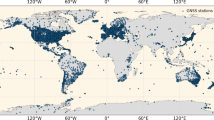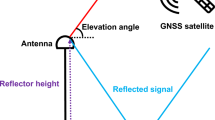Abstract
In this contribution, the BDS3 differential code biases (DCBs) are estimated by using the iGMAS and MEGX networks and the performance of both satellite and receiver DCBs for BDS3 is evaluated with the observational data during the period of DOY 1–180, 2017. The characteristics of BDS3 and BDS2 DCB are compared, and the code inter-system biases (ISB) between BDS3 and BDS2 are also analyzed in detail. The comparison of our estimated BDS C2I-C6I and C2I-C7I DCBs and the DLR and IGG products shows a good agreement. For BDS2, the mean differences are within \( \pm \,0.2\,{\text{ns}} \) and STDs are within 0.15 ns. However, the BDS3 presents a larger difference, with the mean difference of about 0.35 ns, because fewer stations are included in the DLR/IGG processing. The comparison of BDS3 and BDS2 DCB shows that the receiver DCB differences between BDS3 and BDS2 are close to zero for the same network, i.e., iGMAS or MGEX. In other words, there is no significant systematic bias between BDS3 and BDS2 receiver DCB. However, when the iGMAS and MGEX networks are processed together, we found that the receiver DCB differences between BDS3 and BDS2 are not close to zero and present an obvious systematic bias between different networks. The further analysis of code ISB between BDS3 and BDS2 also shows a similar phenomenon. Therefore, the receiver DCB of BDS3 and BDS2 should be separately estimated or calibrated when iGMAS and MGEX networks are processed together. We also analyze the receiver DCB and code ISB between Galileo FOC and IOV satellites and found that there is no such systematic bias between Galileo FOC and IOV satellites. A 180-day analysis of estimated BDS3 and BDS2 DCB shows that the satellite DCBs of BDS3 are fairly stable, with a mean STD of about 0.18 ns. For BDS2, the IGSO DCBs are the most stable with a mean STD of about 0.09 ns, and the GEO DCBs exhibit the worst stability with a mean STD of about 0.18 ns. The mean STDs of receiver DCBs for BDS3 and BDS2 are 0.38 and 0.41 ns, respectively, and the STD of receiver DCBs of BDS3 is smaller than that of BDS2 at most stations.
















Similar content being viewed by others
References
Cai H, Chen G, Jiao W et al (2016) An initial analysis and assessment on final products of iGMAS. In: Sun J, Liu J, Fan S, Wang F (eds) China satellite navigation conference (CSNC) 2016 proceedings: volume III. Lecture notes in electrical engineering, vol 390. Springer, Singapore
Coster A, Williams J, Weatherwax A, Rideout W, Herne D (2013) Accuracy of GPS total electron content: GPS receiver bias temperature dependence. Radio Sci 48(2):190–196
Guo F, Zhang X, Wang J (2015) Timing group delay and differential code bias corrections for BeiDou positioning. J Geod 89:427–445. https://doi.org/10.1007/s00190-015-0788-2
Hernández-Pajares M, Juan JM, Sanz J et al (2009) The IGS VTEC maps: a reliable source of ionospheric information since 1998. J Geod 83(3–4):263–275
Hernández-Pajares M, Roma-Dollase D, Krankowski A et al (2017) Methodology and consistency of slant and vertical assessments for ionospheric electron content models. J Geod 91(12):1405–1414
Jiao W (2014) International GNSS monitoring and assessment system (iGMAS) and latest progress. In: Presented at China satellite navigation conference (CSNC) 2014, Nanjing, 20 May 2014
Jin S, Jin R, Li D (2016) Assessment of BeiDou differential code bias variations from multi-GNSS network observations. Ann Geophys 34:259–269. https://doi.org/10.5194/angeo-34-259-2016
Li X, Ge M, Zhang H et al (2013) The GFZ real-time GNSS precise positioning service system and its adaption for COMPASS. Adv Space Res 51(6):1008–1018
Li X, Ge M, Dai X et al (2015) Accuracy and reliability of multi-GNSS real-time precise positioning: GPS, GLONASS, BeiDou, and Galileo. J Geod 89(6):607–635
Li M, Yuan Y, Wang N, Li Z, Li Y, Huo X (2016) Estimation and analysis of galileo differential code biases. J Geod 91:1–15
Lu M, Yao Z (2014) New signal structures for BeiDou navigation satellite system. In: Stanford’s 2014 PNT symposium, October 2014
Montenbruck O, Hauschild A, Steigenberger P et al (2013a) Initial assessment of the COMPASS/BeiDou-2 regional navigation satellite system. GPS Solut 17(2):211–222
Montenbruck O, Rizos C, Weber R et al (2013b) Getting a grip on multi-GNSS-the international GNSS service MGEX campaign. GPS World 24(7):44–49
Montenbruck O, Hauschild A, Steigenberger P (2014) Differential Code Bias Estimation using Muti-GNSS Observations and Global Ionosphere Maps. Navig J Inst Navig 61:191–201. https://doi.org/10.1002/navi.64
Ren X, Zhang X, Xie W et al (2016) Global ionospheric modelling using multi-GNSS: BeiDou, Galileo, GLONASS and GPS. Sci Rep 6:33499
Schaer S (1999) Mapping and predicting the earth’s ionosphere using the global positioning system. Ph.D. dissertation, The University of Bern, Bern
Shi C, Zhao Q, Hu Z et al (2013) Precise relative positioning using real tracking data from COMPASS GEO and IGSO satellites. GPS Solut 17(1):103–119
Shi C, Fan L, Li M et al (2016) An enhanced algorithm to estimate BDS satellite’s differential code bias. J Geod 90:161–177. https://doi.org/10.1007/s00190-015-0863-8
Tan S, Zhou B, Guo S et al (2010) Studies of compass signals design. In: Proceedings of the 1st China satellite navigation conference. Beijing, 19–21 May 2010
Teunissen P (1985) Zero order design: generalized inverses, adjustment, the datum problem and S-transformations. Optimization and design of geodetic networks. Springer, Berlin, Heidelberg, pp 11–55
Wang N, Yuan Y, Li Z et al (2016) Determination of differential code biases with multi-GNSS observations. J Geod 90:209–228. https://doi.org/10.1007/s00190-15-0867-4
Xiao W, Liu W, Sun G (2016) Modernization milestone: BeiDou M2-S initial signal analysis. GPS Solut 20(1):125–133
Xue J, Song S, Zhu W (2016) Estimation of differential code bias for BeiDou navigation system using multi-GNSS observations: How stable are the differential satellite and receiver code biases. J Geod 90:309–321. https://doi.org/10.1007/s00190-015-0874-5
Yang Y, Li J, Xu J et al (2011) Contribution of the COMPASS satellite navigation system to global PNT users. China Sci Bull 56(26):2813–2819
Yasyukevich Y, Mylnikova A, Kunitsyn V, Padokhin AM (2015) Estimation of GPS/GLONASS differential code biases and their long-time variations. In: Progress in electromagnetics research symposium
Zhang B, Teunissen P (2015) Characterization of multi-GNSS between-receiver differential code biases using zero and short baselines. Sci Bull 60(21):1840–1849
Zhang R, Song W, Yao Y et al (2015) Modeling regional ionospheric delay with ground-based BeiDou and GPS observations in China. GPS Solut 19(4):649–658
Zhang X, Wu M, Liu W et al (2017a) Initial assessment of the COMPASS/BeiDou-3: new-generation navigation signals. DOI, J Geod. https://doi.org/10.1007/s00190-017-1020-3
Zhang X, Xie W, Ren X et al (2017b) Influence of the GLONASS inter-frequency bias on differential code bias estimation and ionospheric modeling. GPS Solut 21(3):1355–1367
Zhao Q, Guo J, Li M et al (2013) Initial results of precise orbit and clock determination for COMPASS navigation satellite system. J Geod 87(5):475–486. https://doi.org/10.1007/s00190-013-0622-7
Acknowledgements
We would like to acknowledge the MGEX, iGMAS, DLR, IGG and CODE, for providing access to GNSS data, differential code bias (DCB) and global ionospheric map (GIM) products. We also acknowledge Professor Zhang Hongping for providing some source code of ionospheric modeling and DCB estimation. This study was financially supported by the National Natural Science Foundation of China (Grant No. 41774030).
Author information
Authors and Affiliations
Corresponding author
Appendix: ISB processing
Appendix: ISB processing
The observation equations for carrier phase and pseudorange can be expressed as follows:
where s and \( r \) represent the satellite and receiver, respectively, j refers to the carrier frequency; ρ s r is the geometric distance between the satellite and receiver; dts and dtr denote the clock biases of satellite and receiver; dr,j and d s j are the code biases of receiver and satellite, while br,j and b s j are the receiver- and satellite-dependent uncalibrated phase delay; λj is the wavelength; N s r, j is the integer ambiguity; I s r, j and T s r represent the ionospheric and tropospheric delay, respectively; e s r, j and ɛ s r, j refer to the measurement noise and multipath error of the pseudorange and carrier phase observations. To eliminate the first-order ionospheric delays, ionosphere-free (IF) combination observations are usually used in POD
Since the satellite state vector at t can be calculated by the initial state at t0 and the state transition matrix, when BDS and GPS are processed together, and the linearized equations for the IF combination observations above can be formed as follows,
where superscript C and G represent the BDS and GPS satellites, respectively; \( \varPsi \) is the unit vector of the direction from receiver to satellite and \( \varPhi \left( {t,t_{0} } \right) \) is the state transition matrix from initial epoch t0 to epoch t; Rr refers to the increment vector of the receiver position; \( m_{{r,{\text{trop}}}} \) represents the wet mapping function; and \( {\text{ZTD}}_{r} \) refers to the residual part of the zenith wet tropospheric delay. O0 is the initial satellite orbit state vector; x0, y0, z0 are the initial positions of satellite; while \( \dot{x}_{0} \), \( \dot{y}_{0} \)\( \dot{z}_{0} \) are the velocity; \( {\text{SRP}}_{1}^{G} ,{\text{SRP}}_{2}^{G} , \ldots ,{\text{SRP}}_{n}^{G} \) denote to the solar radiation pressure parameters. In one receiver, the code delays of BDS (\( d_{{r,C,{\text{IF}}}} \)) and GPS (\( d_{{r,G,{\text{IF}}}} \)) are different, and this difference is a kind of inter-system biases (ISBs). In the process, we usually estimate the GPS receiver clock and the code ISB parameters for BDS relative to GPS. Thus, Eq. (13) can be rewritten as:
where \( dt_{r,G} = dt_{r} + c \cdot d_{{r,G,{\text{IF}}}} \) is the receiver clock of GPS; \( {\text{ISB}}_{{r,G\_C,{\text{IF}}}} = b_{{r,C,{\text{IF}}}} - b_{{r,G,{\text{IF}}}} \) is code ISB parameters for BDS relative to GPS. In this study, we performed the GPS + BDS3 and GPS + BDS2 POD processing. The receiver clocks of BDS2 and BDS3 can be obtained as follows:
where \( {\text{d}}t_{r,C2} \) and dtr,C3 refer to the receiver clock biases for BDS2 and BDS3, respectively; dtr,G and dt ’ r, G are the receiver clock biases for GPS obtained from GPS + BDS2 and GPS + BDS3 POD, respectively; \( {\text{ISB}}_{r,G\_C2} \) and ISBr,G_C3 are the code ISBs of BDS2 and BDS3 relative to GPS. It should be noted that different receiver clock may be chosen as reference for GPS + BDS2 and GPS + BDS3 POD; the estimated receiver clocks of GPS may be different even for the same station. To remove this bias, a receiver clock is set as reference, and the other receiver clocks are subtracted by the reference clock,
where Δtr,C2 and Δtr,C3 refer to the receiver clocks after removing reference clock for BDS2 and BDS3, respectively. The reference clock only affects the estimated absolute clock of receiver, but it has no effect on the relative clock between the receivers. So the relative receiver clock \( t_{r,G} - t_{{{\text{ref}},G}} \) is equal to \( t_{r,G}^{'} - t_{{{\text{ref}},G}}^{'} \), although different reference clocks may be applied by them. The difference between BDS2 and BDS3 receiver clocks after removing reference clock can be obtained as:
Rights and permissions
About this article
Cite this article
Li, X., Xie, W., Huang, J. et al. Estimation and analysis of differential code biases for BDS3/BDS2 using iGMAS and MGEX observations. J Geod 93, 419–435 (2019). https://doi.org/10.1007/s00190-018-1170-y
Received:
Accepted:
Published:
Issue Date:
DOI: https://doi.org/10.1007/s00190-018-1170-y




